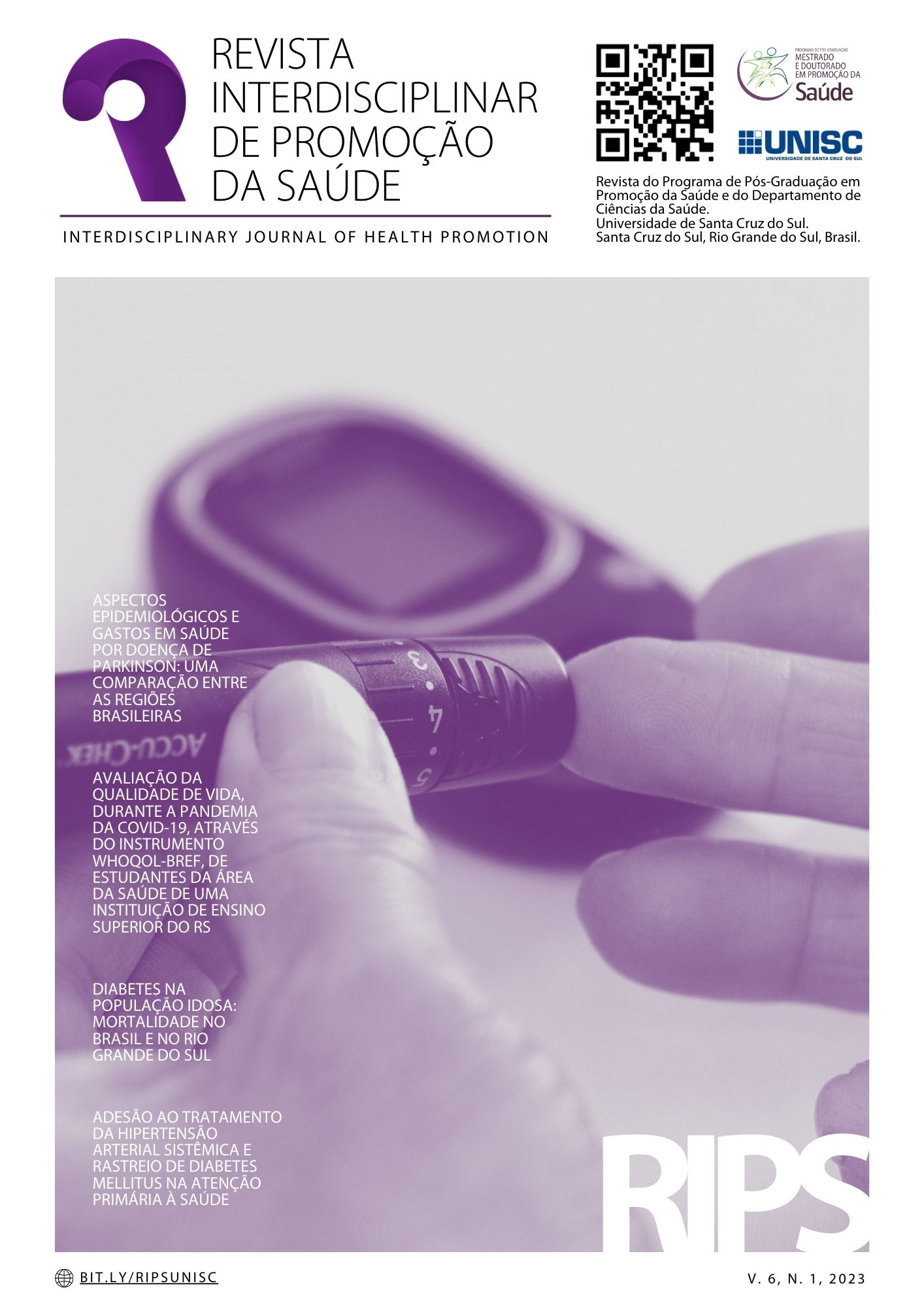Assessment of quality of life, during the COVID-19 pandemic, through the WHOQOL-bref instrument, of students in the health area of a higher education institution RS
DOI:
https://doi.org/10.17058/rips.v6i1.17996Keywords:
Quality of life, Teaching, StudentsAbstract
Objective: To evaluate the quality of life of students in courses in the health area of a higher education institution during the pandemic caused by the new coronavirus. Methods: The sample consisted of 59 students from undergraduate courses in the health area who answered the Google Forms containing questions about socioeconomic profile and quality of life assessment using the WHOQOL-bref instrument. Results: 13 were male and 46 were female. The mean age was 23.05 ± 6.17 years, the majority (98.4%) being white (85.5%), single, and 56.3% residing in Lajeado, RS. Most respondents are studying Medicine and do not fit into the risk groups for COVID-19. When asked about returning to face-to-face classes, the frequency with which they have attended the university and the practice of other activities, most said they were participating in face-to-face classes. Regarding quality of life, it is observed that the scores of the domains: physical, psychological, environment and quality of life were higher in women, although not significantly different. However, the general quality of life of the students was good. Conclusions: So far, there are no studies that assess the quality of life of students, and studies like this are relevant to know the reality of students during the pandemic, as well as for universities to outline teaching strategies aimed at training and quality of life. students' lives.
Downloads
References
Fleck, MPA. O instrumento de avaliação de qualidade de vida da Organização Mundial da Saúde (WHOQOL-100): características e perspectivas. Cienc Saud Colet, 2000;5(1):33-38. doi:https://doi.org/10.1590/S1413-81232000000100004
Fleck MPA, Louzada S, Xavier M, Chachamovich E, Vieira G, Santos L et al. Aplicação da versão em português do instrumento abreviado de avaliação da qualidade de vida “WHOQOL-bref” Rev. Saúde Pública, 2000;34(2):178-83. doi: https://doi.org/10.1590/S0034-89102000000200012
Zhou P, Yang XL, Wang XG, Hu B, Zhang L, Zhang W, et al. A pneumonia outbreak associated with a new coronavirus of probable bat origin. Nature. 2020; 579(7798):270-273. doi:https://doi.org/10.1038/s41586-020-2012-7
Ferguson NM, Laydon D, Nedjati-Gilani G, Imai N, Aisme K, Baguelim M. et al. Impact of non-pharmaceutical interventions (NPIs) to reduce COVID-19 mortality and healthcare demand. Impl College London, 2020;3–20. doi:https://doi.org/10.25561/77482
Erduran, S. Science Education in the Era of a Pandemic. Sci & Educ, 2020; 29, 233–235. doi: https://doi.org/10.1007/s11191-020-00122-w
UNESCO. COVID-19 Ruptura e resposta educacional. Disponível em: https://en.unesco.org/themes/education-emergencies/coronavirus-school-closures.Acessado em junho de 2022.
Minayo MCS. Pesquisa social qualitativa para compreensão da COVID-19. Enferm. Foco 2020; 11 (3): 4-5.
Li HY, Cao H, Leung DYP, Mak YW. The Psychological Impacts of a COVID-19 Outbreak on College Students in China: A Longitudinal Study. Int J Environ Res Public Health. 2020; 2;17(11):3933.doi: https://doi.org/10.3390/ijerph17113933
Jones EAK, Mitra AK, Bhuiyan AR. Impact of COVID-19 on Mental Health in Adolescents: A Systematic Review. Int J Environ Res Public Health. 2021;3;18(5):2470. doi:https://doi.org/10.3390/ijerph18052470
Santos APR, Vidal JN, Souza A, Silva BRVS, Costa EC, Oliveira MCP, de Aquino JM, dos Santos MAM, de Barros MVG, da Silva LMP, Correia Junior MAV. Impact of Covid-19 on the mental health, quality of life and level of physical activity in university students. Rev Bras Ativ Fis Saúde. 2022 ;27.doi: https://doi.org/10.12820/rbafs.27e0266
Buss PM. Promoção da saúde e qualidade de vida. Cienc Saud Colet 2000;5(1):163-177.doi: https://doi.org/10.1590/S1413-81232000000100014
Brasil. Ministério da educação- MEC. 13 de janeiro de 2011. Disponível em: http://portal.mec.gov.br/ultimas-noticias/212-educacao-superior-1690610854/16227-mulheres-sao-maioria-entre-os-universitarios-revela-o-censo. Acessado em 27 de junho de 2023.
Cao W, Fang Z, Hou G, Han M, Xu X, Dong J, Zheng J. The psychological impact of the COVID-19 epidemic on college students in China. Psychiatry Res. 2020; 287, 112934. doi:https://doi.org/10.1016/j.psychres.2020.112934
Komer, L. COVID-19 amongst the pandemic of medical student mental health. Int. J. Med. Stud. 2020;8, 56–57. doi:https://doi.org/10.5195/ijms.2020.501
Quek TT, Tam WW, Tran BX, Zhang M, Zhang Z, Ho CS, Ho RC. The Global Prevalence of Anxiety Among Medical Students: A Meta-Analysis. Int J Environ Res Public Health. 2019; 31;16(15):2735. doi:https://doi.org/10.3390/ijerph16152735.
Silva RS, Costa LA. Prevalência de transtornos mentais comuns entre estudantes universitários da área da saúde. Encontro:Rev de Psicologia. 2012; 15(23):105-112.
Beltrame KWDS, Trindade-Suedam IK, Trindade SHK, Marzano-Rodrigues MN. Web survey during COVID-19 pandemic in São Paulo state: how are medical students sleeping and living? Sleep Sci. 2022; 15(4):374-382. doi:https://doi.org/10.5935/1984-0063.20220066
World Health Organization. Rational use of personal protective equipment for coronavirus disease (COVID-19) and considerations during severe shortages. Interim Guidance. Geneve: WHO; 2020. Disponível em: https://www.who.int/publications/i/item/rational-use-of-personal-protective-equipment-for-coronavirus-disease-(covid-19)--and-considerations-during-severe-shortages. Acessado 22 de junho de 2022.
Dyrbye LN, Thomas MR, Shanafelt TD. Systematic review of depression, anxiety, and other indicators of psychological distress among U.S. and Canadian medical students. Acad Med. 2006;81(4):354-73.doi: https://doi.org/10.1097/00001888-200604000-00009
Frajerman A, Morvan Y, Krebs MO, Gorwood P, Chaumette B. Burnout in medical students before residency: A systematic review and meta-analysis. Eur Psychiatry. 2019 Jan;55:36-42. https://doi.org/10.1016/j.eurpsy.2018.08.006
Jacobson NC, Newman MG. Anxiety and depression as bidirectional risk factors for one another: A meta-analysis of longitudinal studies. Psychol Bull. 2017; 143(11):1155-1200. doi:https://doi.org/10.1037/bul0000111
Pankiewicz P, Majkowicz M, Krzykowski G. Anxiety disorders in intimate partners and the quality of their relationship. J Affect Disord. 2012;140(2):176-80 .doi:https://doi.org/10.1016/j.jad.2012.02.005

Downloads
Published
How to Cite
Issue
Section
License
A submissão de originais para este periódico implica na transferência, pelos autores, dos direitos de publicação impressa e digital. Os direitos autorais para os artigos publicados são do autor, com direitos do periódico sobre a primeira publicação. Os autores somente poderão utilizar os mesmos resultados em outras publicações indicando claramente este periódico como o meio da publicação original. Em virtude de sermos um periódico de acesso aberto, permite-se o uso gratuito dos artigos em aplicações educacionais e científicas desde que citada a fonte conforme a licença CC-BY da Creative Commons.



